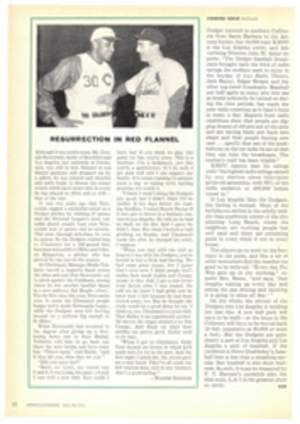
The Pleasures of the Picnic
The day is fulgent, the countryside is lush. The queen's privy buckhounds can be heard above the two thin copper sounds of the horn, and in a sun-dappled glade the royal cook has begun to unpack hampers filled with cold roast meats, pigeon pies, hams and wines aplenty. Queen Elizabeth has elected to picnic. Time: 1576. Scene: the Forest of Arden.
Such a moment of dining alfresco is surely as old as man himself—and as contemporary as the gathering at the right (on the hillside overlooking the course of the Maryland Hunt, a sporting event which is a four-minute steeplechase but an all-day picnic). It is the mood that counts, whether the occasion is extravagant or strictly entre nous. Sir Walter Scott loved lavish picnics at which his guests angled for leaping trout and the host cooled the wine by tying the bottles with string to dangle in the chilly brook. A generation earlier, Horace Walpole recalled an outdoor meal of seven minced chickens stewed over a spirit lamp by a highborn lady, and a dessert of strawberries purchased from a strolling fruit vendor.
Formal or familiar, a picnic mood should be a festive mood, to bring to eating a touch of adventure. In this era of gadgetry, no lady need hover over an 18th century lamp nor, indeed, is the temperature of a man's potation dependent upon the proximity of running water. Ours is the era of gracious outdoor living, and it cries out for imaginative menus. Picnics should be repasts to which jaded males come eagerly rather than eying them as arduous bouts against discomfort and soggy vittles.
Picnics (the word is an 18th century adaptation from the French pique-nique) may have thrived first in the ages of chivalry and romance, but they took on an entirely different coloration when they crossed the Atlantic. In pioneer America picnics built log cabins, raised barns, threshed wheat; there were husking bees, soap boilings, quilting bees, tree-felling drives. All picnics. As the need for community effort passed, the gregarious pleasure of eating out of doors has lingered on as a social custom that ranges from block parties to clambakes and tail gate feasts (SI, Oct. 14, 1957) to the mile-long line of tables at the annual Iowa picnic in California. Here is a heritage which requires little more than good weather and good spirits to get the cook out of the kitchen and into the open.
But it does take planning. The trick is to prepare as much of the food as possible ahead of departure. Pack the ice chest with salad dressings and perishables to keep them cool en route to the picnic site. And have an overabundance of food; appetites have a way of increasing out of doors. The suggestions I list to the right are my own tested successes for satisfying the most ravenous pique-niqueur.
A RIVIERA SANDWICH
For variety with a certain amount of dash, try French rolls served in the manner that is known as pain baigné, or bathed bread. Cut the rolls in half lengthwise and rub generously with garlic. Spread with slices of black olives, pimiento or green pepper, tomatoes, onions, anchovies, artichoke hearts, lettuce. Pour over the rolls a liberal quantity of French salad dressing (three parts oil to one part vinegar), join the halves and put the sandwiches under heavy weight for half an hour. This is the classic repast of outdoor bowlers on the French Riviera, as well as a favorite of swimmers at Nice and Cannes. Red wine is indicated with this hearty delicacy.
CORNISH PASTIES
Cornish pasties are meat pies that date back to the Middle Ages and make a surprise hit on a picnic. Combine pound of diced round steak, cup of diced raw potatoes, 1¼ cups chopped onions, salt and pepper to taste. Roll pie dough ‚⅛ inch thick and cut into 5-inch rounds. Heap 3 tablespoons of filling on each, sprinkle with tablespoon of chopped parsley and dot with butter. Fold the dough, moisten edges and crimp; prick the top and brush with beaten egg. Bake in moderate oven 45 minutes; then make a small incision and add two tablespoons of heavy cream; bake 15 minutes longer. Pasties are good cold, or they can be wrapped in foil and reheated over the grill.
CHAMPAGNE AND TURKEY
Pack the ice chest with bottles of champagne. Start the meal with cold borsch, followed by baby turkey tarragon, Mediterranean rice, asparagus salad and pineapple ice. Make a marinade of one cup each of white wine and olive oil and ¼ cup of tarragon. Have a baby turkey split and the backbone removed; marinate overnight. At the picnic baste frequently while the bird broils over hot coals 1½ hours. Boil a cup of rice, and while warm add French dressing. Season with salt, pepper, grated nutmeg. Add a tablespoon each of minced tarragon and basil, chopped parsley, black olives, red and green pimientos. Decorate with quartered tomatoes and let stand to cool.
PHOTO
DAN WEINER

